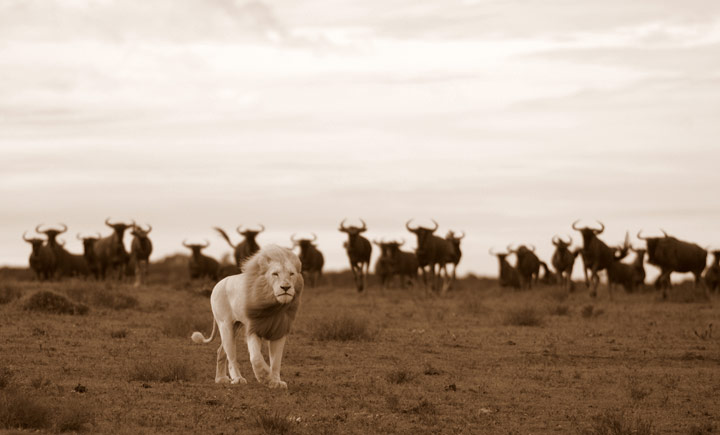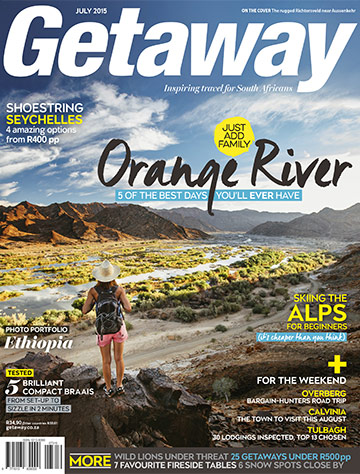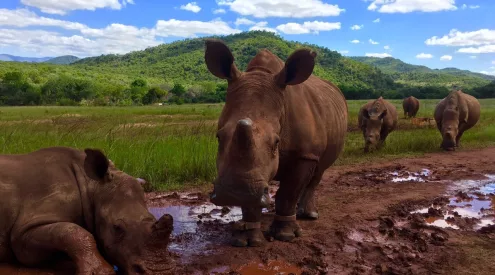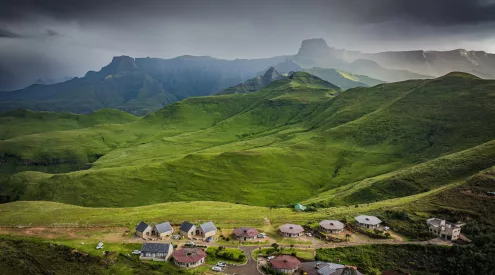Adam Cruise shares insight into the trade of captive-bred lions to save the wild ones.
Let us know what you think: Share your thoughts in our comments section below and you could get one of 10 free tickets to the 2015 Durban International Film Festival to see the controversial documentary Blood Lions.

The roar sounded close, real close, but I figured it must be at least a kilometre and a half away. Nothing to worry about, I reasoned. With that I turned back to the pot brewing on the fire. But then a low growl nearby caused me to spin around. And there, sauntering straight towards me, was a huge male lion with shaggy mane and all. He had seen me. I suspect he had for a while. Evidently he was just passing through, perhaps re-establishing his territory and had warned me with a grunt. Still, a lion is a lion and being out in the open with a wild animal of this size and reputation tested the primeval urge to turn and run. Somehow I remained stock-still and the nonchalant cat continued right past. He paused briefly to sniff my flask, then continued slowly on his way issuing a mighty roar in parting as if to say, ‘So long, and thanks for the coffee.’
Sadly, my wild lion encounter may soon be relegated to mythological status. African range lions have declined alarmingly over the last several decades due to rampant poaching and habitat loss. In an effort to save them from extinction, South Africa’s Department of Environmental Affairs has just released its first-ever Biodiversity Management Plan for lions.
The draft plan notes that in 2008 Asian traders started taking an interest in lions when the decline in tigers became acute. Tiger wine, made using powdered bones, allegedly cures many ills. Lion bones are now filling the gap with a sharp increase in lion products turning up in the markets of Vietnam, Laos and China. The demand in lion bones could potentially threaten South Africa’s 2300 wild lions, and given what’s happened with rhinos, there are fears that a similar fate awaits them. The Department, though, believes it has a solution.
Currently in South Africa there are around 174 captive-lion breeding facilities where lions are bred exclusively for trophy hunting. A breeder can get paid anywhere from R60000 to R300000 per lion shot, but can boost his earnings by selling a lion skeleton, worth another R12000 to R24000. These, I discovered, are sold legitimately to a Chinese dealer in Durban or Johannesburg. The skeleton, once boiled down and bottled in Asia, could reach a market value exceeding R200000. So, the thinking is that if consumer demand is satiated by a surplus of captive-bred lion products, wild lions ought to be left alone. On average, according to government, breeders keep 104 lions per facility with an average of 68 lions hunted annually. That’s over 7000 lion skeletons a year, more than enough to satisfy demand. Or is it?
Apart from the obvious ethical concerns about captive-bred hunting, stimulating an Asian market for lion products could lead to an increase in demand, far beyond the productivity of lion breeders. As far as I’m aware, the trade model to combat wildlife crime has never produced positive results. In the past, attempts to farm tigers for their bones and bears for their bile have resulted in an increase in illegal trade, while a once-off sale of their huge ivory stockpiles by the southern African bloc of countries to China in 2008 had the exact opposite of the intended effect of satisfying ivory demand. It’s unlikely therefore that South Africa’s lions will be saved by a policy of trading their bones. If anything, trade will doom them to a more rapid extinction.
If trade in lion bones does spell doom for wild lions, at least, as some pro traders have similarly argued about farming rhinos for their horn, the species is saved from extinction, albeit in a quasi- domestic form. However, my sentiment is that extinction means the death of essence, not just existence. The loss of being wild is tantamount to extinction. ‘A thing is right,’ said the late American ecologist Aldo Leopold, and father of modern conservation, ‘when it tends to preserve the integrity, stability, and beauty of the biotic community. It is wrong when it tends otherwise.’
In simple economic terms wildlife that is no longer wild negatively affects tourism ‒ and much-needed income for conservation. Wildlife-watching tourism is big business for Africa. According to a recently published study by the United Nations World Tourism Organization, Africa is the world’s main destination for wildlife-watching tourism with 80 per cent of the total annual visitors to the continent coming exclusively for nature-based safaris. It’s a growing market segment, too, thanks to an explosive rise in wildlife media coverage and Internet communication. A global awareness of the risk of extinction and the moral stigma of killing for trade contributes heavily to tourists’ motivation to observe wild animals ranging freely in their natural habitats.
And there’s the rub. Tourism and trade cannot work in conjunction, at least in Africa. Visitors to the last bastion of free-ranging wild animals do not want to pay money to gawk at an overfed cat in an enclosure knowing that some part of its carcass is eventually going to be shipped overseas to support a nefarious trade.
Environmental journalist and safari operator Ian Michler has been reporting on the predator breeding and canned hunting industries since 1999.
‘Breeders that make profits from both the tourism industry and lion bone trade are putting SA’s conservation reputation in serious peril,’ says Michler.
The story of these practices is being told in a controversial documentary Blood Lions, which will be screened for the first time at the Durban International Film Festival on 22 July 2015 at 6pm.
We want to hear your thoughts. Share them in our comments section below and you could get a complimentary ticket to the 2015 Durban International Film Festival Blood Lions.
This article first appeared in the July 2015 issue of Getaway magazine.
We want to hear your thoughts. Share them in our comments section below and you could get a complimentary ticket to the 2015 Durban International Film Festival.



















